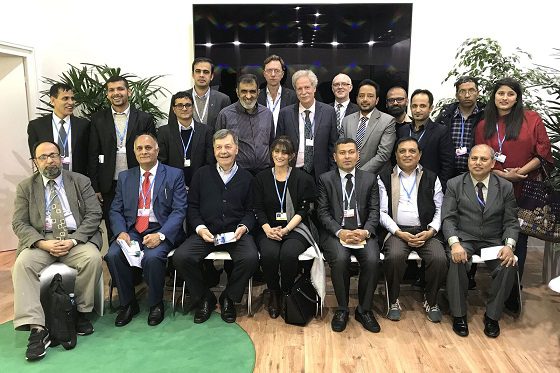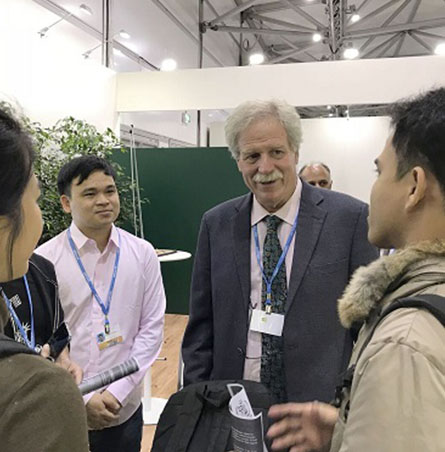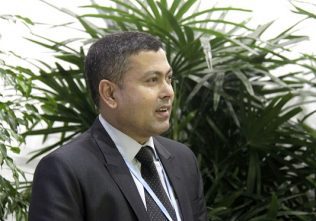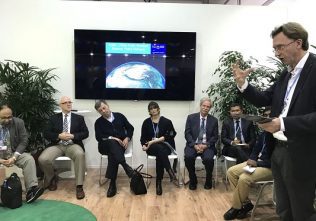This site uses cookies, as explained in our terms of use. If you consent, please close this message and continue to use this site.
During the 23rd session of the Conference of the Parties (COP) of the UNFCCC in November 2017 in Bonn, Germany, ICIMOD organized a number of side events, hosted an exhibition booth and participated in a range of relevant meetings and events with the objective of highlighting the mountain agenda in a global discourse.
On 14 November, during a high level side event on ‘Cooperation for Building Resilient Mountain Communities’, government representatives from all eight countries of the Hindu Kush Himalayan (HKH) region pledged a commitment for collaboration at multiple scales to cope with the impacts of climate change that are affecting the lives of people and biodiversity in the mountain ecosystem. The event, which was jointly organized by the German Federal Ministry for the Environment Nature Conservation, Building and Nuclear Safety (BMUB) and ICIMOD, brought together environmental ministers, and representatives of expert institutions from the HKH region.
 Participants at the event
Photo: ICIMOD
Participants at the event
Photo: ICIMOD
During another side event on 7 November, representatives from the two ends of the geographical spectrum, the small islands and high mountains, gathered to discuss and share experiences for improving climate action and sustainable development pathways. Fulfilling the requisites of successful climate action and sustainable development is a challenge, particularly for high mountain and small island regions which have distinct and unique geographical characteristics. The key to dealing successfully with these challenges lies in ensuring community participation. It is an essential criterion for ensuring the sustainability of climate action. With the aim of bringing perspectives from Nepal and the Pacific Islands, the discussion took place at during a session on Coordinated Action on Sustainable Development and Climate Change, jointly hosted by Ministry of Population and Environment (MoPE) – Government of Nepal, Institute for Advanced Sustainability Studies (IASS) and ICIMOD.
The Arctic and the HKH are both climate change hotspots facing similar challenges related to high latitude and high altitude ecosystems. Both regions contend with air pollution, cryospheric change and natural resource degradation, and both regions have large indigenous populations that are disproportionately affected by these challenges.
At another side event held on 11 November, experts and representatives from these regions stressed the urgent need for sustainable development and environmental protection, which can be achieved through successful collaboration between the respective regional countries.
Citing similarities between the Arctic and the HKH, David Molden, Director General of the International Centre for Integrated Mountain Development (ICIMOD), said, “Both regions have established regional collaboration institutions. In the Arctic, this work is conducted through the Arctic Council, which serves as a high-level intergovernmental forum to address issues facing the countries and indigenous peoples of the Arctic. In the HKH, ICIMOD, also an intergovernmental organization, serves the countries and mountain people of the region as a knowledge development and learning centre.”
Bishwa Nath Oli, Secretary at Nepal’s Ministry of Population and Environment (MoPE) emphasized the importance for upstream-downstream interactions in the 10 large river basins of the HKH. These basins are home to approximately two billion people, including 240 million who live in upstream mountains and hills. “The impact of climate change on glaciers, snow, and ice in the mountains of the HKH requires more extensive research, both in situ and through remote sensing. This can provide a good foundation for regional collaboration,” he said.
 1
1
 2
2
 3
3
Inspired by the success of the Arctic Monitoring and Assessment Programme (AMAP), a working group of the Arctic Council, ICIMOD is currently coordinating a comprehensive assessment of the HKH region, conducted as part of the larger Hindu Kush Himalayan Monitoring and Assessment Programme (HIMAP). Philippus Wester, HIMAP Coordinator and Chief Scientist, Water Resources Management at ICIMOD said, “HIMAP brings together hundreds of scientists and policy experts to create an evidence-based, comprehensive assessment, which will greatly assist in addressing threats, acting on opportunities, and scaling cutting edge approaches.”
The participants agreed that the range of adaptation innovations and solutions in the HKH, frequently pioneered by the region’s inhabitants on the ground, also provide good opportunities for exchange and collaboration between the eight countries of the region.
Strengthening the interactions and interfaces between science, policy, and practice is becoming increasingly urgent in the face of accelerated warming in the mountains and hills of the HKH. The session participants recommended that ICIMOD take the lead in organizing regular regional Science-Policy Dialogues, as an important mechanism to work towards the establishment of an HKH Science-Policy Forum.
These discussion took place on 11 November during a side event at the Pakistan Pavilion in the Bonn Zone, COP23 venue. The aim of the event was to strengthen exchange and collaboration between the Arctic and HKH. The event was jointly hosted by the Ministry of Climate Change (MoCC), Government of Pakistan and ICIMOD. Other speakers at the event included Syed Abu Ahmad Akif, Secretary to the Government of Pakistan, MoCC, Bruce Currie-Alder, International Development Research Centre (IDRC), Canada, and government and media representatives from Nepal, Myanmar, and Pakistan.
ICIMOD’s delegation is at the COP23 in Bonn, Germany organizing and attending various activities. For a complete list of events, please visit our dedicated webpage for COP23: www.icimod.org/cop23. For any questions, please write to Udayan Mishra: Udayan.Mishra@icimod.org
Stay up to date on what’s happening around the HKH with our most recent publications and find out how you can help by subscribing to our mailing list.
Sign Up